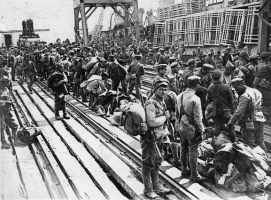Introduction↑
The Ecumenical Patriarchate, also known as the Patriarchate of Constantinople, was founded in the year 38 AD in the ancient city of Byzantium by Andrew the Apostle (c. 5 AD - 60 AD). The Ecumenical Patriarch was considered the highest authority of the Orthodox Church and spiritual leader of the Rum milleti, the Orthodox Christian community of the Ottoman Empire. Following the Fall of Constantinople in 1453 the patriarchal see was moved to various parts of the city until its establishment in the district of Phanar in 1601. The principles of the Tanzimat were proclaimed in 1839 with the decree of Gülhane (Gülhane Hatt-ı şerif) and reaffirmed with the Reform Edict (Islahat Fermanı or Hatt-ı Hümayun) of 1856, which introduced significant changes to the administration of the Rum milleti. According to the final text of the “National” (Ethnikoi) or “General Ordinances” (Genikoi Kanonismoi) ratified by the porte in 1862, the affairs of the Rum milleti would be administered by the Ecumenical Patriarch and two bodies: the Holy Synod, composed of twelve metropolitans of the Ecumenical Throne and the “Permanent National Mixed Council” (Diarkes Ethniko Mikto Symvoulio), comprising four metropolitans from the Holy Synod and eight lay representatives.[1]
The Reform Edict confirmed and maintained the immunities and privileges that had been attributed to the Ecumenical Patriarch of Constantinople in the past, but also officially recognized and established the role of the lay element in the administration of the community. The privileges of the patriarchate were further curtailed under the policies of the Committee of Union and Progress (İttihad ve Terakki Cemiyeti, henceforth CUP), which became the ruling party following the Young Turk Revolution of July 1908.[2] The revolution signified the beginning of the political radicalization of both Muslims and non-Muslims within the empire and the formation of a framework of violent and mutually exclusive nationalisms, eventually resulting in the Greco-Turkish War of 1919-1922 and the collapse of the Ottoman state. The Ecumenical Patriarchate was not exempt from this political process. On the contrary, it played an active role.
The CUP’s “Shadow War” Against Non-Muslims and the Official Protests of Ecumenical Patriarch Germanos V↑
The defeat of the Ottoman Empire in the Balkan Wars (October 1912 - August 1913), and the consequent territorial losses and violent uprooting of great numbers of Muslims from the Balkans, constituted a watershed moment for the cohesion of Ottoman society. For the CUP, the wars served as ultimate proof that the loyalty of the non-Muslims living within the realm of the empire lay with foreign powers. In this context, they were also perceived as a clear indication of the non-Muslims’ reluctance to join the envisioned Ottoman nation. From 1914 onwards, and especially after the entry of the Ottoman Empire into World War I on the side of the Central Powers in October of that year, the CUP exercised both structural and physical violence along political and economic lines, mainly against Armenians and Greeks with the aim of “purifying” Asia Minor from its non-Muslim populations. This included boycotts as part of the policy of National Economy (Milli Iktisat), violent displacements, ethnic cleansing and genocidal policies.[3]
Patriarch Germanos V’s (1835-1920) most consistent and substantial effort to protest against these violent political practices took place between February 1914 and June 1915. During this period, he communicated a series of memoranda (takrir) to Mehmet Reşat V, Sultan of the Turks (1844-1918), Grand Vizier Said Halim Pasha (1863-1921), and the Minister of Justice and Public Worship Pirizade İbrahim Hayrullah Bey (1839-1934). The patriarch emphasized his institutional role in the administrative structure of the Ottoman state in an attempt to exert pressure on the Sublime Porte. He noted that the government’s reluctance to put an end to this persecution was a violation of the constitution, the imperial decrees of the Tanzimat reforms, and the laws, undermining not only the authority but also the very existence of the patriarchate as an institution of the state apparatus. Furthermore, on 27 May 1914, Germanos declared the Church was in a state of mourning, closing all the churches and schools as the ultimate form of demonstration against the violent displacements that had taken place in Asia Minor, Pontus, the Sea of Marmara, and Thrace.[4] The Ottoman authorities for their part denied, or in some cases downplayed, the gravity of the events. They avoided taking responsibility for any violence by attributing the displacement of the Rum populations either as an inevitable consequence of the war or due to external, especially Greek, incitement, as well as repeatedly making empty promises to restore order in the region. Thus, the Ottoman authorities actually rejected the claims of the patriarchate.[5]
Politically marginalized and rather affected by the open state persecution of the Armenian Patriarchate of Constantinople, Germanos gradually developed a relationship of convenience with the government, despite his discontent regarding its actions at the expense of his flock. Similarly, the Rum deputies in the Ottoman parliament, all of them elected with the CUP in 1914, were forced to operate in a hostile environment, especially after Greece entered the fray on the side of the Triple Entente in June 1917. On the rare occasions that they did decide to complain as a group against state violence, their efforts were obstructed at the last minute by Patriarch Germanos, who instead advocated an indirect approach of behind-the-scenes negotiations with the government.[6] Despite the fact that many in the Rum community at the time saw this approach as passive and thus controversial, it could nonetheless be argued that his overall attitude protected the Orthodox Greeks from an even worse fate during the war, perhaps even one comparable to that of the Armenians of the empire.
Megali Idea and the Creation of Greater Greece↑
The defeat of the Ottoman Empire in the autumn of 1918, combined with the strong popular resentment towards the ineffectual policy of the Ecumenical Patriarchate during the Great War, enabled the adherents of Greek nationalism to overthrow Patriarch Germanos V just days before the signing of the Armistice of Mudros (30 October 1918) and take over the reins of the Rum milleti. Germanos was succeeded by the Metropolitan of Bursa Dorotheos [Mammelis] (1861-1921) who became locum tenens of the Ecumenical Throne. With the parallel encouragement of Greek Prime Minister Eleftherios Venizelos (1864-1936), the new clerical/lay leadership openly adopted the Greek irredentist policy of the Megali Idea (Great Idea), namely the ambition of Greece to liberate the so-called Alytrotoi Ellines (Unredeemed Greeks) from Ottoman rule and create a Greater Greece that would annex Greek-populated territories of the empire into an expanded Greek nation. The failure of Venizelos in the elections of November 1920 was a turning point for the patriarchate, which under the leadership of the newly-elected Patriarch Meletios IV [Metaxakis] (1871-1935) – an ardent Venizelist and Greek nationalist – shifted its policy from enosis (unification) with Venizelos’ Greece to the creation of a separate state for the unredeemed Greeks in the Near East, in reaction to monarchist Athens. However, the defeat of the Greek army in the Greco-Turkish War of 1919-1922, followed by the burning of Smyrna, and the atrocities committed against the non-Muslims of the city by Turkish nationalist forces in the autumn of 1922 put an end to their national aspirations.[7]
Dimitris Kamouzis, Centre for Asia Minor Studies
Managing Editor: Nazan Maksudyan
Section Editor: Erol Ülker
Notes
- ↑ Kamouzis, Dimitris: Greeks in Turkey. Elite Nationalism and Minority Politics in Late Ottoman and Early Republican Istanbul, Oxford et al. 2021, pp. 8-9.
- ↑ Ibid., pp. 22-24.
- ↑ Kamouzis, Dimitris: Out of Harm’s Way? Structural Violence and the Greek Orthodox Community of Istanbul during World War I, in: Journal of the Ottoman and Turkish Studies Association 4/1 (2017), pp. 189-211. Cf. Çetinkaya, Doğan Y.: The Young Turks and the Boycott Movement. Nationalism, Protest and the Working Classes in the Formation of Modern Turkey, London et al. 2013, pp. 119-203; Erol, Emre: The Ottoman Crisis in Western Anatolia. Turkey’s Belle Époque and the Transition to a Modern Nation State, London et al. 2016, pp. 163-203.
- ↑ Ecumenical Patriarchate: Persecution of the Greeks in Turkey 1914-1918, Constantinople 1919, pp. 130-142.
- ↑ Ibid., pp. 130, 135-142.
- ↑ Emmanouilidis, Emmanouil: Τα τελευταία έτη της Οθωμανικής Αυτοκρατορίας [The Final Years of the Ottoman Empire], Athens 1924, pp. 290-292, 309-327, 331, 339-366, 372-374.
- ↑ For a detailed account of this period see Kamouzis, Greeks in Turkey 2021, pp. 43-124.
Selected Bibliography
- Çetinkaya, Doğan Y.: Young Turks and the Boycott Movement. Nationalism, Protest and the Working Classes in the Formation of Modern Turkey, London 2013: I. B. Tauris.
- Ecumenical Patriarchate, Constantinople: Persecution of the Greeks in Turkey, 1914-1918, London 1919: Hesperia Press.
- Emmanouilidis, Emmanouil: Τα τελευταία έτη της Οθωμανικής Αυτοκρατορίας [The final years of the Ottoman Empire], Athens 1924: Τύποις Γ.Η. Καλλέργη.
- Erol, Emre: The Ottoman Crisis in Western Anatolia. Turkey’s Belle Époque and the Transition to a Modern Nation State, London, New York 2016: I. B. Tauris.
- Kamouzis, Dimitris: Greeks in Turkey. Elite Nationalism and Minority Politics in late Ottoman and Early Republican Istanbul, University of London, Abingdon, Oxon 2021: Routledge.
- Kamouzis, Dimitris: Out of Harm's Way? Structural Violence and the Greek Orthodox Community of Istanbul during World War I, in: Journal of the Ottoman and Turkish Studies Association 4/1, 2017, pp. 189-211.










